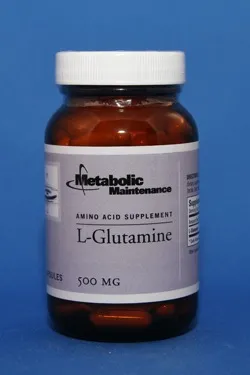
L-Glutamine
Glutamine, or L-Glutamine, is the most abundant amino acid circulating on its own in the body. Glutamine is an important component of a functioning immune system, the maintenance of a healthy intestinal lining, as well as certain mental and emotional processes. It can be found in many foods and under “routine” circumstances, the body seems to have adequate supply between what is eaten and what the body makes for itself. However, when the body is stressed (injury, surgery, chemotherapy, or prolonged exercise), supplementation with glutamine has been found to be helpful in recovery or prevention of subsequent illness. It is considered a vital supplement for helping to heal the “leaky gut syndrome” that is so often a part of food allergies.
First Aid Applications. I see Glutamine’s role in the home vitamin/medicine chest in two areas.
- Brain function and sweets cravings related? Perhaps because it is a precursor in the body’s production of the neurotransmitter GABA, glutamine is for many people a helpful supplement to focus a sleepy or foggy brain. Glutamine can provide a useful form of fuel to the brain when it seems to be having a “low sugar” moment. People eating a low carbohydrate diet, particularly in the first few weeks, complain at times of “brain fog”, that urges them back towards the now forbidden afternoon sweet snack. L-glutamine, taken in doses of 500 mg to 2000 mg seems to re-awaken their brain and in many folks also diminishes the sugar cravings! Double bonus from a supplement with a very good safety profile.
- Oh my stomach, what did I eat? Just what I was wondering two days ago when something in my gut felt explosive (that was quickly taken care of) and then persistently irritated and unsettled. Glutamine is a vital tool used by the cells of the intestinal wall to keep healthy or repair the lining of the intestinal tract. I myself took, and frequently recommend for patients with a bout of stomach or intestinal upset, 1000 mg, 2-3 times a day. Gets everything feeling normal again quite promptly. I am so comfortable in its effectiveness, that if symptoms persist after three days, I know it’s time for further tests to see what else might be going on.
Food sources of glutamine. The best sources of glutamine are meat, eggs, and dairy. Although many vegetables (beans, leafy greens) also contain glutamine, they are harder to digest and less of the glutamine present is absorbed. As I mentioned above, under normal circumstances body stores of glutamine are abundantly filled from the foods we eat and the magic our body is able to perform, synthesizing any we need that is not present. Only under certain stresses is more needed, and in those cases, it is almost always true that the supplement will work more quickly and easily.
How to take it. Glutamine comes in both capsule and powder form. For most uses, the capsules are most convenient. I have long used Metabolic Maintenance L-Glutamine in my practice and usually start people with the capsules. For the First Aid uses mentioned above, the capsules are an easy way to have glutamine available through the day as needed. If I am working with someone with food allergies or leaky gut, where their dosage might be several grams daily (one to ten thousand milligrams, or one to ten grams), they are usually happiest using the powder and mixing it into a food or drink.

